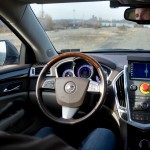 While it is easy to assume riding in an autonomous vehicle will be a largely passive experience, in the short to medium term it’s almost certainly going to be a more cooperative experience, with the human driver having to remain vigilant so that they can regain control when required.
While it is easy to assume riding in an autonomous vehicle will be a largely passive experience, in the short to medium term it’s almost certainly going to be a more cooperative experience, with the human driver having to remain vigilant so that they can regain control when required.
New research from the University of Cambridge attempts to shed some light onto how this cooperation might unfold. The research uses cooperative game theory to attempt to model the kind of interactions that may occur inside the vehicle.
Game theory
The researchers create a scenario based upon the Pareto equilibrium, which describes a balanced state in which neither the car or the human are willing to change their steering choices on their own. This scenario is often far from ideal however as both man and machine can have conflicting ideas about the best course of action. This is typified by the famous trolley dilemma that continues to confound autonomous car developers.
To test their theory, the researchers created another approach that revolved around non-cooperative game theory. It seems that a more cooperative approach helps to reinforce the control the driver has over the steering wheel, which helped them to regain control of the vehicle.
The authors are at pains to point out that they don’t advocate firm conclusions to be drawn from their work, but do instead hope that they might inform the development of automated steering technology so that it’s better able to take account of our real-live steering experience and therefore ensure there is more effective and safer shared control between human drivers and the car.